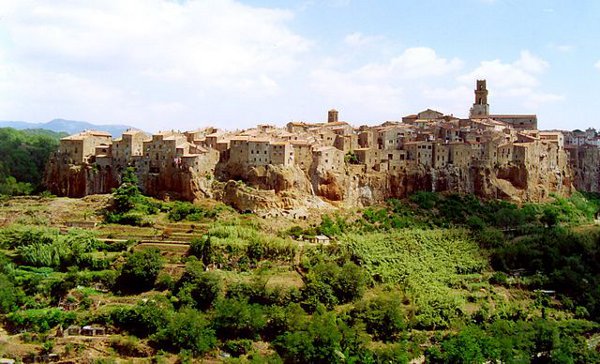Pitigliano is a typical village of the Maremma, the only one of its kind for the distinction of being built entirely on a tufa rock, which makes it one of the most interesting places of the tuff.
Also known for the traditional feast of “Torciata of St. Joseph” in which, burning a puppet symbolic bids farewell to winter, the country over the years has become an important tourist destination of the Maremma.
The territory has been inhabited since very ancient times, as it can be easily proved by many finds of Etruscan origin, as the necropolis and the vie cave, excavated in the areas surrounding the village, Legend has it that the town was founded by two young , Petilio and Celiano that, escaping from their city after stealing an important object decided to take refuge in this part of Tuscany, founding a new country.
Currently, recent archaeological excavations, it appeared that Pitigliano was home to prehistoric appropriations already during the various phases of the Bronze Age (2000 – 1000 BC). Later it became the seat of an important Etruscan settlement of which there are parts of walls and numerous cemeteries. The Etruscan name of Pitigliano is not known, perhaps it was Statnes (or Staties) which in Roman times became Prefecture and was called Pitigliano Statonia.Il name instead derives from the gens Petilia, an important Roman family who gave their name to different locations . Dall’862 begins the domain of the family Aldobrandesca which lasts until the end of the thirteenth century. In 1293, following the marriage of the heir of the family Aldobrandesca, Anastasia, with Roman Gentile Orsini, Pitigliano became a county of this family Guelph. Until the end of 1400 it became an important center for the Jews, so much so that in 1598 was erected a temple still exists. In the seventeenth County passed under the rule of the Medici and the first half of the eighteenth century became part of the Duchy of which follow the fate until the unification of Italy.
The old traditions and customs of the Tuscan village are told in museums that have been set up: the Museum of Civilization Giubbonaia, which collects antique tools used in the country and houses the Museum of Palazzo Orsini, the Civic Museum and Archaeological Museum and Finally, the Open Air Museum “The City of the Living, The City of the Dead”, dedicated to Etruscan history in the area.
Pitigliano is very rich in monuments and buildings that tell the story, walking through the village you can in fact meet the imposing Cathedral, built during the sixteenth century and dedicated to Saints Peter and Paul, the Church of Santa Maria, formerly named San Rocco, the Sanctuary of the Madonna delle Grazie, Palazzo Orsini, the Fortezza Orsini and finally the Monument to the Progeny Ursinea, consisting of a mass of stone with the family coat of arms surmounted by a bear arms.
Just outside the town is the Jewish Cemetery appointment. In the Ghetto Synagogue, built in 1598 has recently been restored and in adjacent rooms was built a Museum of Art and Jewish Culture. In the alleys underlying develop various rooms dug into the tuff: the ritual bath, the kosher butcher and the wine cellar, the oven of unleavened bread, all recovered and can be visited. “
Appreciable is also the DOC wine “Bianco di Pitigliano” and “Red Sovana.”
To savor the sweets, the so-called “Eviction” in the form of small sticks with honey and nuts that in the folk tradition, shape recalls the stick with which he was knocked on the door when authorities performed eviction.
http://tuscanysea.com/backoffice/immagini/tuscanysea.com/31-17-5-2013-11-44-451.jpg
http://tuscanysea.com/backoffice/immagini/tuscanysea.com/31-17-5-2013-11-44-452.jpg

